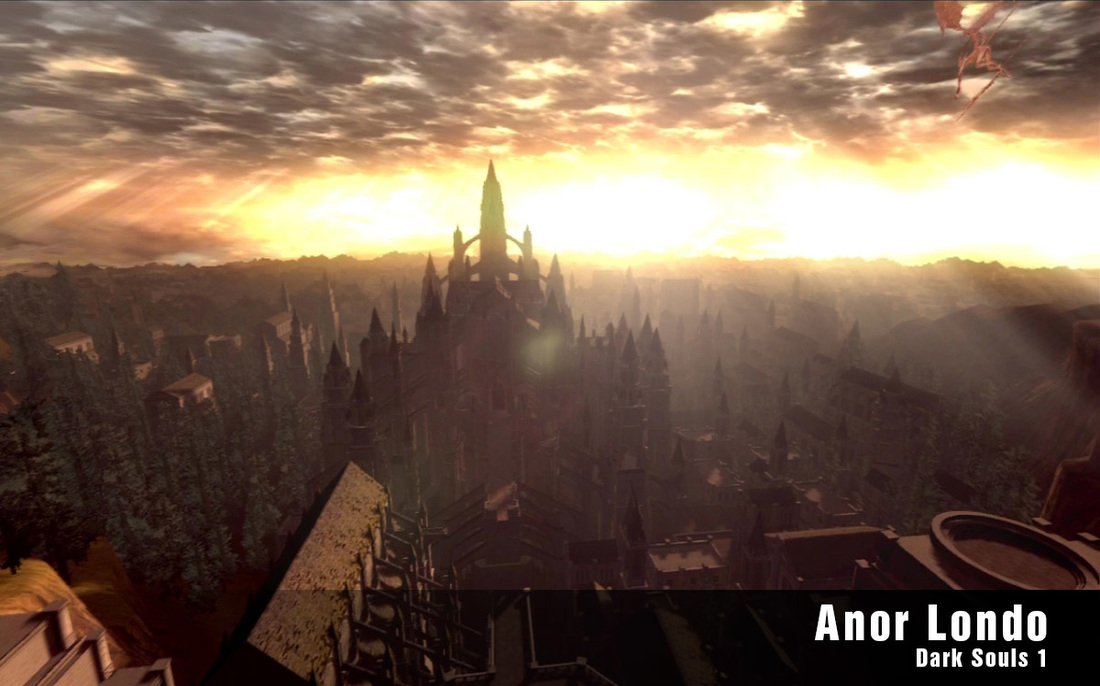|
|
Personal Projects
|
|
|
For the past two weeks I’ve been deeply into Dark Souls 3. I knew I was going to want to do a post about playing this game, but I’ve been really struggling about what I’d like to talk about. There’s so much that I find engaging, from the dynamic enemy animations to the atmospheric storytelling … there’s a lot to be applauded here. Yet what I can’t shake is how harrowing this experience has been. The Dark Souls franchise is known for it's intense experiences that leave players rattled… but Dark Souls 3 has felt different. In this blog post we’re going to talk a lot about lore (major spoilers ahead, but I do not talk about the Dark Souls 3 ending), relationships between Dark Souls 1 and 3, and I’m going to try to be discussing this all in a way that doesn’t alienate people who haven’t been keeping up with Dark Souls lore. I’m going to be making a lot of opinion statements and I may get some of the lore slightly wrong, so I apologize if I do!
away and dying. Dark Souls 3 plays with these emotions in very purposeful ways, by first introducing you to characters that are alive and well. In the very beginning of the game we’re introduced to a blacksmith named Andre. Fans of the series will recognize this blacksmith as the same one from Dark Souls 1, which makes this a very fun moment for the players who recognize him. This immediately sets to the tone as being heavily connected to Dark Souls 1, and leaves the player feeling optimistic about who they might meet and where they might go. It’s purposeful and an interesting choice for the developers to start with. As you complete the second boss of the game, Bat Demons appear to whisk you away into the next area. Those who are familiar with Dark Souls 1 will recognize these guys and this very similar sequence from the first game where these Demons carry you to, the most iconic location in the Dark Souls franchise, Anor Londo. The beginning segments of the game are all about familiarity, hope, and excitement for what comes next. As a fan of the franchise, this really sets up the vibe of the game early on.
Moving ahead, we end up in a place called Smouldering Lake that feels very similar to a location in Dark Souls 1 called the Demon Ruins or Lost Izalith. Izalith is notable from a lore perspective because it’s essentially the birthplace of Demons in the Dark Souls 1 universe. It’s a location filled with lava, old ruins, and is basically a large cave type area. In this area, the player soon finds that the side passageways are full of dead Demons from Dark Souls 1. Stacked in piles, or just sprawling out on the floor are different demon forms that were previously enemies. Seeing this kind of mass slaughter
here!” after discovering him. An odd silver lining to have in such a grim scenario. In the same area the player will also find an old corpse of what appears to be a spider, but after taking a closer look is most likely Quelaan, a character from Dark Souls 1 that is half spider half woman. In Dark Souls 1 you find her half sunken into a wall, blind but you can talk to her.
Princess of Sunlight. In Dark Souls 1 if you attack Gwynevere it’s revealed that she’s an illusion created by her brother Gwyndolin, when the illusion is broken the Sunlight vanishes and plunges the city into a dark night. Gwyndolin is the youngest son of Lord Gwyn, has an affinity for the Moon, and remains as the only god in Anor Londo to protect his father’s honorary tomb. If the illusion is not broken, Gwyndolin remains in hiding as an optional boss to this area (I’ve never broken the illusion and fought this character). Going back to Irithyll, as you descend into this area you begin to find more references to Anor Londo. There’s a room that’s not only guarded by Silver Knights but also has pictures on the wall depicting Gwynevere and other imagery from Anor Londo. As you ascend Irithyll you begin fighting more Silver Knights on roof tops, which is a familiar nod to the same setting in Dark Souls 1 where you have to climb rooftops in Anor Londo while avoiding arrows from Silver Knights. In one
on screen text announcing the name of the area. It’s important to note that in the context of Dark Souls 3 we know that we’re in pursuit of a boss named Aldrich, who has been known for consuming kings… essentially eating his way to the top but at this point that’s all the player knows. From here the player moves forward into the same area that’s before the Ornstein and Smough boss fight from Dark Souls 1, and as you move into the same room you fought them in… you
There’s another item reveals more of the chaos that Adlrich has wrought, which reads : “Aldrich dreamed as he slowly devoured the God of the Darkmoon. In this dream, he perceived the form of a young, pale girl in hiding.” Deciphering this we can understand the God of the Darkmoon to be Gwyndolin that’s being consumed, and we can infer that the young, pale
found Priscilla, the same magic seemed to have been used to block access to Irithyll, and the player is required to find a doll to access the area. Just like Gwyndolin, Priscilla had been left to be and yet found a horrific end. It’s not like Anor Londo was in a great state when we saw it last, but there was still something majestic about it… Finding it defiled in Dark Souls 3, I found myself practically mourning the loss of innocence. Discovering the empty room where the illusion of Gwynevere is meant to be, the city fallen to darkness and cold, and knowing that any vestiges of Gwyn are now truly gone. It’s like returning to your childhood home and finding the tree that held your tree-house has died, and pieces of it is are now just molding and crumbling away. You want to play in that tree-house, and while it’s still physically there, it’s really not your tree-house anymore. In Dark Souls 1, the major theme was about how Gwyn and others saw the end of their era approaching and their attempts at unnaturally prolonging it. Nothing is meant to last forever and yet we can’t help but want it to… it’s such a human emotion and yet we’re seeing it play out in game form. Playing Dark Souls 1 it was very easy to be like “No we need to end the era of Gwyn!” Yet this question has become more difficult. I think it’s cannon to say that the era was prolonged unnaturally at the end of Dark Souls 1 and in Dark Souls 3 we’re seeing the result of that. We’re seeing a world we love, be on life support for too long. It’s such a harsh reality and analogy to make… but this is where Fromsoftware have brought us. I will say that there have been certain “other discoveries” made that’s after Aldrich that pushes the player deeper into questioning this era… and if it’s really right to keep the flame going. Dark Souls guides us through this complicated arc of emotions where we struggle with nostalgia and I think places us in a very similar scenario as Gwyn. Where we feel for this world and in many ways want to keep it going, even when we shouldn’t. Everything fades in time, and we can’t always cling to the past. Dark Souls is teaching us to let go… and telling us to get out of that tree-house, the tree died years ago.
I’d be lying if I said my thesis wasn’t deeply inspired by this article, which relates Dark Souls with dementia (would really recommend a read).
0 Comments
Have you ever done something evil in a video game? Something that’s perhaps a bit morally ambiguous? Who was the target? What made you do it? I’ve continued my journey in The Division and, as you can imagine, it’s got me thinking about morality. A lot of games highlight morality as a feature, “Press R2 to be Renegade,” but we don’t often think about passive morality that can happen within gaming. When it’s not an inherent game choice, doesn’t modify a player stat, or the game won’t tell you that you’re being evil. Today I’d like to explore the question “Do we struggle with morality more when it comes to game characters versus other people?” This is very subjective, and will most likely turn into an opinion piece, but I’ll try to back it up with as much information as possible. Yet if you disagree, all the better! In this post we'll be talking about a variety of games but I don't believe there are any spoilers you should worry about.... enjoy!
you’re asked to perform a paragon or renegade action and in doing so either will actually modify a stat and how your avatar looks. While emotionally strong, these games encourage people to think about their choices in a very active way. In this regard, I want to rule these out of the conversation as early as possible. Life doesn’t have visual feedback for when I perform a “good” or a “bad” choice. When games passively allow for morality choices, it’s much more interesting to see how people react.
A simple example of this, was a story a friend shared with me about an experience he had in Minecraft. Upon first going into “The Nether” or Minecraft’s hell area, he was greeted by the inhabitants of this world… the Zombie Pigmen. Right away he started slaughtering them, only to realize that they weren’t actually hostile at all… just ugly. This stuck with him as a bad choice he made in a game and he always felt a little bad about murdering their village.
universe this is the point where someone has been undead for so long that they have lost all remnants of who they once were and have lost their mind. He wanders his tomb, in a circle, naked with his clothes in the corner, unaware of the player. Vendrick will never attack you unprovoked, yet you can attack and kill him if you’d like. I always found this to be so sad, also knowing his knight was guarding… really nothing. In all my playthroughs of this game, I’ve never killed him.
subsequently died with laughter. While it was initially an accident, it sort of then became a test for me. Whenever I was summoned into this area, I’d go for the switch and see which players would survive, and who wouldn’t. I was a monster, as I watched countless players slowly dip their way into the lava and die.
Typically when engaging other players in Darksouls, and other games, I do tend to worry that they are going to be trolls in some regard. Yet there was one instance where I summoned another player into my game (a person by the name of Chiri Pepe) for some help. At one point he disappeared and I worried that I was left to my own devices… constantly paranoid of what enemy Darksouls going to throw at me next. I went to open a door and there was a huge enemy preparing to swing his weapon down and kill me. In this moment Chiri Pepe fell, seemingly out of nowhere, and killed the enemy who would have led to my imminent death. Chiri Pepe was a hero, he hadn’t left me to my own devices, he selflessly ran off to protect me from an unknown threat. I remember being in such awe in this moment and Chiri Pepe lived on as a Legend when I think back on Darksouls.
to go to a specified area, call in a helicopter, and wait for it to arrive. While it’s enroute, all other players in the area know what you’re doing, can come and try to kill you, and steal your loot. That’s the scary part about the Dark Zone, players can kill other players and steal the loot they’ve found. Not only do you lose your loot when you die, but you also lose some experience… so it can actually force you to lose levels. Even though when you kill another player, you show up as a “Rogue Agent” that other players have to try to kill within a certain amount of time… it really doesn’t stop a lot of aimless murder. I’ve seen players do some really tricky things to avoid this,like intentionally jumping into someone’s line of fire and forcing that player into a “Rogue Agent” status.There’s also a mechanic for allowing players to hear other players if they are in close enough proximity to them… I once made the mistake of exclaiming loudly that I had found a legendary item, only to find myself quickly a target for other players. It’s pretty nerve racking and the tension is high in the Dark Zone.
tried to be as helpful as possible to other players… yet as I saw some the harshness that is the Dark Zone, it was very alluring to fall to the “dark side.” A friend and I were following these other players as they were running around looking for loot. At the time my friend and I were both level somewhere in the mid 30’s. While following these other players, they weren’t aware that we could actually hear all of their conversations. Their nervousness about us, just egged us on… and when one of them was excited about being level 14, it made us laugh. They suddenly felt like “fresh meat,” and we were the predators. Why did my mind go there? Why did it feel like survival of the fittest? I suddenly felt like I had such inherent power over this other player, so much so I could bully him if I wanted to. Deciding who is your ally and who is your nemesis can happen at a moment’s notice. There were certain players who I felt obligated to help but then other players who became my arch enemies. So much so that if I saw that this player might be extracting their loot, I would definitely go and try to ruin their day as fast as I could.
Although I feel as though I’ve seen a lot of harshness in the Dark Zone, I do feel as though I’ve seen some genuine acts of kindness. At one point there was a group of us together, not in a party, but all hunting down a Rogue Agent. One of the players in the party did accidentally shoot me and become Rogue. I immediately shot back at him, damaging him, and everyone else nearby leveled their guns at him. He quickly used the surrender emote and for whatever reason it gave us all pause. We knew it was an accident, yet we could all easily kill him in this moment, take his loot, get experience, and have no repercussion. After a tense moment, we slowly lowered our weapons… no one fired, we didn’t speak to each other but we all silently agreed that we weren’t going to kill him. It felt like such an interesting moment for me, after seeing so much happen in the Dark Zone.. something about this act really gave me some faith back in people.
behavior is encouraged in these games, due to the mechanics allowing it, and that we’re just victim to the design of the game. Yet I don’t agree, by simply allowing it doesn't make it a core value of the game. I would wonder if there was more negative visual feedback after performing an “evil action” if it would change anything… but I still support the design of the game remaining neutral. At the end of all of this the only inference that I’d make is that players will make drastically different moral choices depending on the style of game they are playing. Not saying that people won’t be good, I’ve experienced acts of kindness in these zones, but it’s just a very different dynamic. One that feels much less forgiving.
|
AuthorI make games, I play games... and sometimes I have some thoughts about that. Archives
March 2024
|
Proudly powered by Weebly




















 RSS Feed
RSS Feed